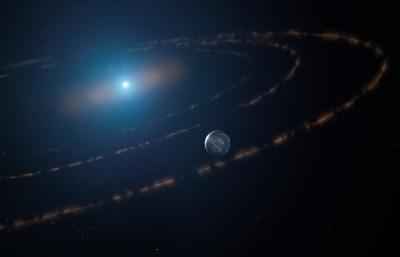Planetary bodies observed in habitable zone of dead star
- Ring of debris around a white dwarf star suggests presence of a planet in the right location to support water, and potentially life
- First time astronomers have detected any kind of planetary body in the habitable zone of a white dwarf
- Discovery made using ULTRACAM, co-developed by University of Warwick
 A ring of planetary debris studded with moon-sized structures has been observed orbiting close to a white dwarf star, hinting at a nearby planet in the “habitable zone” where water and thus life could exist, according to a new study involving astronomers from the University of Warwick.
A ring of planetary debris studded with moon-sized structures has been observed orbiting close to a white dwarf star, hinting at a nearby planet in the “habitable zone” where water and thus life could exist, according to a new study involving astronomers from the University of Warwick.
White dwarfs are glowing embers of stars that have burned through all their hydrogen fuel. Nearly all stars, including the Sun, will eventually become white dwarfs, but very little is known about their planetary systems.
In the study, led by UCL researchers and published in Monthly Notices of the Royal Astronomical Society, an international team measured light from a white dwarf in the Milky Way known as WD1054–226, using data from ground- and space-based telescopes.
To their surprise, they found pronounced dips in light corresponding to 65 evenly spaced clouds of planetary debris orbiting the star every 25 hours. The researchers concluded that the precise regularity of the transiting structures – dimming the star’s light every 23 minutes – suggests they are kept in such a precise arrangement by a nearby major planet.
The discovery was made using the high-speed camera ULTRACAM, developed and operated through a two decade-long collaboration between researchers at the universities of Warwick and Sheffield. Warwick is world-leading in the study of white dwarf systems and planetary debris material around white dwarfs.
Professor Tom Marsh of the University of Warwick Department of Physics said: "Objects of this type, in which we see planetary material passing across the face of a star, are exceedingly rare. They allow us to probe the dynamics and even the composition of planetary systems far beyond our Solar System.
"With ULTRACAM we could see the system change before our eyes, and it was obvious that the system was extraordinary during the first night that we observed it from the telescope in Chile."
Lead author Professor Jay Farihi (UCL Physics & Astronomy) said: “This is the first time astronomers have detected any kind of planetary body in the habitable zone of a white dwarf.
“The moon-sized structures we have observed are irregular and dusty (e.g. comet-like) rather than solid, spherical bodies. Their absolute regularity, one passing in front of the star every 23 minutes, is a mystery we cannot currently explain.
“An exciting possibility is that these bodies are kept in such an evenly-spaced orbital pattern because of the gravitational influence of a nearby major planet. Without this influence, friction and collisions would cause the structures to disperse, losing the precise regularity that is observed. A precedent for this ‘shepherding’ is the way the gravitational pull of moons around Neptune and Saturn help to create stable ring structures orbiting these planets.
“The possibility of a major planet in the habitable zone is exciting and also unexpected; we were not looking for this. However, it is important to keep in mind that more evidence is necessary to confirm the presence of a planet. We cannot observe the planet directly so confirmation may come by comparing computer models with further observations of the star and orbiting debris.”
For the new study, researchers observed WD1054–226, a white dwarf 117 light years away, recording changes in its light over 18 nights using the ULTRACAM high-speed camera fixed on to the ESO 3.5m New Technology Telescope (NTT) at the La Silla Observatory in Chile. In order to better interpret the changes in light, the researchers also looked at data from the NASA Transiting Exoplanet Survey Satellite (TESS), which allowed the researchers to confirm the planetary structures had a 25-hour orbit.
The study received funding from the UK’s Science and Technology Facilities Council (STFC) and involved a team of researchers from six countries, including Boston University, the University of Warwick, Lund University, the University of Cambridge, the University of St Andrews, Wesleyan University, the University of La Laguna, Naresuan University, the University of Sheffield, and the Instituto de Astrofísica de Canarias.
Ends
Notes to Editors
Artwork is available to download here: https://www.dropbox.com/s/jl5f58cohgi6tce/whitedwarfhzplanet.jpg?dl=0
Please credit Mark Garlick and only use the image in relation to this study.
Caption: An artist’s impression of the white dwarf star WD1054–226 orbited by clouds of planetary debris and a major planet in the habitable zone.
The research appears in ‘Relentless and Complex Transits from a Planetesimal Debris’, Jay Farihi et al., published in Monthly Notices of the Royal Astronomical Society, in press. Available at https://academic.oup.com/mnras/article-lookup/doi/10.1093/mnras/stab3475
11 February 2022
University of Warwick press office contact:
Peter Thorley
Media Relations Manager (Warwick Medical School and Department of Physics) | Press & Media Relations | University of Warwick
Email: peter.thorley@warwick.ac.uk
Mob: +44 (0) 7824 540863
